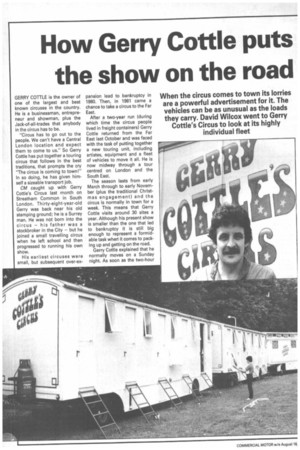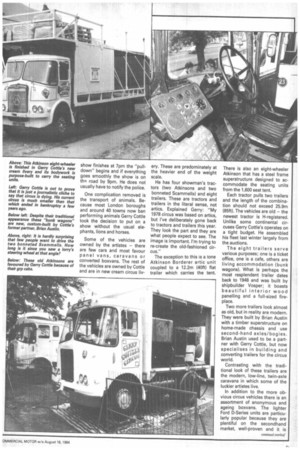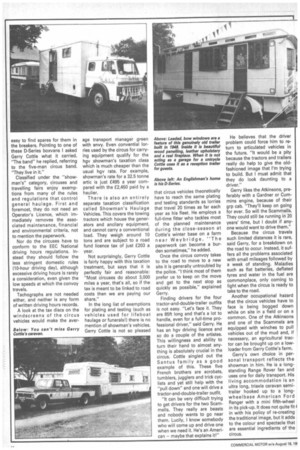How Gerry Cottle puts the show on the road
Page 44

Page 45

Page 46

If you've noticed an error in this article please click here to report it so we can fix it.
When the circus comes to town its lorries are a powerful advertisement for it. The vehicles can be as unusual as the loads they carry. David Wilcox went to Gerry Cottle's Circus to look at its highly individual fleet
GERRY COTILE is the owner of one of the largest and best known circuses in the country. He is a businessman, entrepreneur and showman, plus the Jack-of-all-trades that anybody in the circus has to be.
"Circus has to go out to the people. We can't have a Central London location and expect them to come to us." So Gerry Cottle has put together a touring circus that follows in the best traditions, that prompts the cry "The circus is coming to town!" In so doing, he has given himself a sizeable transport job.
CM caught up with Gerry Cattle's Circus last month on Streatham Common in South London, Thirty-eight-year-old Gerry was back near his old stamping ground; he is a Surrey man. He was not born into the circus — his father was a stockbroker in the City — but he joined a small travelling circus when he left school and then progressed to running his own show.
His earliest circuses were small, but subsequent over-ex
pansion lead to bankruptcy in 1980. Then, in 1981 came a chance to take a circus to the Far East.
After a two-year run (during which time the circus people lived in freight containers) Gerry Cottle returned from the Far East last October and was faced with the task of putting together a new touring unit, including artistes, equipment and a fleet of vehicles to move it all. He is now midway through a tour centred on London and the South East.
The season lasts from early March through to early November (plus the traditional Christma s engagement) and the circus is normally in town for a week. This means that Gerry Cottle visits around 30 sites a year. Although his present show is smaller than the one that led to bankruptcy it is still big enough to represent a formidable task when it comes to packing up and getting on the road.
Gerry Cottle explained that he normally moves on a Sunday night. As soon as the two-hour show finishes at 7pm the "pulldown" begins and if everything goes smoothly the show is on thci road by 9pm. He does not usually have to notify the police.
One complication removed is the transport of animals. Because most London boroughs and around 40 towns now ban performing animals Gerry Cottle took the decision to put on a show without the usual elephants, lions and horses.
Some of the vehicles are owned by the artistes — there are few cars and most favour panel vans, caravans or converted boxvans. The rest of the vehicles are owned by Cottle and are in new cream circus liv ery. These are predominately at the heavier end of the weight scale.
He has four showman's tractors (two Atkinsons and two bonneted Scammells) and eight trailers. These are tractors and trailers in the literal sense, not artics. Explained Gerry: "My 1978 circus was based on artics, but I've deliberately gone back to tractors and trailers this year. They look the part and they are what people expect to see. The image is important. I'm trying to re-create the old-fashioned circus."
The exception to this is a lone Atkinson Borderer artic unit coupled to a 12.2m (40ft) flat trailer which carries the tent. There is also an eight-wheeler Atkinson that has a steel frame superstructure designed to accommodate the seating units from the 1,600 seat tent.
Each tractor pulls two trailers and the length of the combination should not exceed 25.9m (85ft). The vehicles are old — the newest tractor is H-registered. Unlike some continental circuses Gerry Cottle's operates on a tight budget. He assembled his fleet last winter largely from the auctions.
The eight trailers serve various purposes; one is a ticket office, one is a cafe, others are living accommodation (bunk wagons). What is perhaps the most resplendent trailer dates back to 1948 and was built by shipbuilder Vosper; it boasts beautiful interior wood panelling and a full-sized fireplace.
Two more trailers look almost as old, but in reality are modern. They were built by Brian Austin with a timber superstructure on home-made chassis and use second-hand axles/bogies. Brian Austin used to be a partner with Gerry Cottle, but now specialises in building and converting trailers for the circus world.
Contrasting with the traditional look of these trailers are the modern, low-line, twin-axle caravans in which some of the luckier artistes live.
In addition to the more obvious circus vehicles there is an assortment of anonymous and ageing boxvans. The lighter Ford D-Series units are particularly popular because they are plentiful on the secondhand market, well-proven and it is easy to find spares for them in the breakers. Pointing to one of these D-Series boxvans I asked Gerry Cottle what it carried. "The band" he replied, referring to the five-man circus band. "They live in it."
Classified under the "showman's" category, circuses and travelling fairs enjoy exemptions from many of the rules and regulations that control general haulage. First and foremost, they do not need an Operator's Licence, which immediately removes the associated maintenance, financial and environmental criteria, not to mention the paperwork.
Nor do the circuses have to conform to the EEC National driving hours regulations. Instead they should follow the less stringent domestic rules (10-hour driving day), although excessive driving hours is rarely a consideration, even given the low speeds at which the convoy travels.
Tachographs are not needed either, and neither is any form of written driving hours records.
A look at the tax discs on the windscreens of the circus vehicles would make the aver age transport manager green with envy. Even convential lorries used by the circus for carrying equipment qualify for the hgv showman's taxation class which is much cheaper than the usual hgv rate. For example, showman's rate for a 32.5 tonne artic is just £495 a year compared with the £2,450 paid by a haulier.
There is also an entirely separate taxation classification called Showman's Haulage Vehicles. This covers the towing tractors which house the generators and ancilary equipment, and cannot carry a conventional load. They weigh around 10 tons and are subject to a road fund licence tax of just £203 a year.
Not surprisingly, Gerry Cottle is fairly happy with this taxation treatment, but says that it is perfectly fair and reasonable: "Most circuses do about 3,000 miles a year, that's all, so if the tax is meant to be linked to road costs then we are paying our share."
In the long list of exemptions for plating and testing (such as vehicles used for lifeboat haulage or funerals!) there is no mention of showman's vehicles. Gerry Cottle is not so pleased that circus vehicles theoretically have to reach the same plating and testing standards as lorries that travel 20 times as far each year as his fleet. He employs a full-time fitter who tackles most of the planned maintenance during the close-season at Cottle's winter base on a farm near Weybridge. "The paperwork can become a bur den sometimes," he added. Once the circus convoy takes to the road to move to a new site it is generally untroubled by the police. "I think most of them prefer us to keep on the move and get to the next stop as quickly as possible," explained Gerry.
Finding drivers for the four tractor-and-double-trailer outfits is not easy. "Let's face it, They are 85ft long and that's a lot to handle, even for a full-time professional driver," said Gerry. He has an hgv driving licence and so do a couple of the artistes. This willingness and ability to turn their hand to almost anything is absolutely crucial in the circus. Cottle singled out the Santus family as a good example of this. These five French brothers are acrobats, tumblers, jugglers and trick cyclists and yet still help with the "pull down" and one will drive a tractor-and-double-trailer outfit.
"It can be very difficult trying to get drivers for the two Scammells. They really are beasts and nobody wants to go near them. Lucily, I know somebody who will come up and drive one when we need it. He's an American — maybe that explains it!" He believes that the driver problem could force him to re turn to articulated vehicles in the future. "It would be a pity because the tractors and trailers really do help to give the oldfashioned image that I'm trying to build. But I must admit that they do look daunting to a driver."
Gerry likes the Atkinsons, preferably with a Gardner or Cum mins engine, because of their grp cab. "They'll keep on going for ever. So will the Scammells.
They could still be running in 20 years' time, but I doubt if anyone would want to drive them," Because the circus travels such limited distances it is rare, said Gerry, for a breakdown on the road to occur. Instead, it suffers all the problems associated with small mileages followed by a week of standing. Maladies such as flat batteries, deflated tyres and water in the fuel are commonplace, only coming to light when the circus is ready to take to the road.
Another occupational hazard that the circus vehicles have to face is being bogged down while on site in a field or on a common. One of the Atkinsons and one of the Scammels are equipped with winches to pull vehicles out of the mud and, if necessary, an agricultural tractor can be brought up on a lowloader from Gerry Cottle's farm.
Gerry's own choice in personal transport reflects the showman in him. He is a long standing Range Rover fan and uses one for daily transport. His living accommodation is an ultra long, triaxle caravan semitrailer hooked up to a long
wheelbase American Ford Ranger with a mini fifth-wheel in its pick-up. It does not quite fit 4
in with his policy of re-creating the traditional image, but it adds to the colour and spectacle that are essential ingredients of the circus.








































































